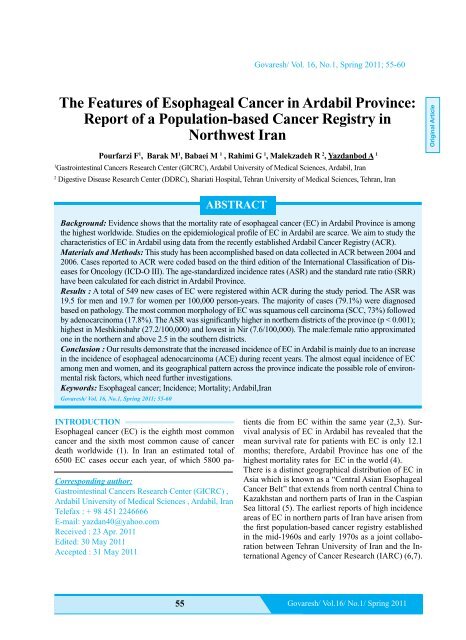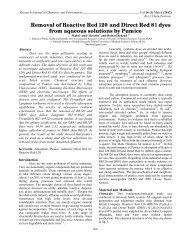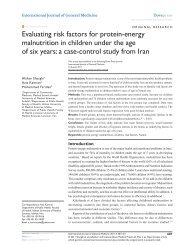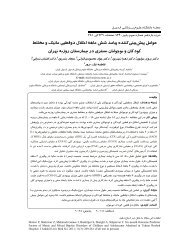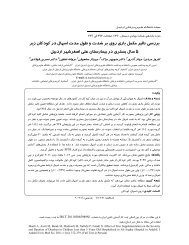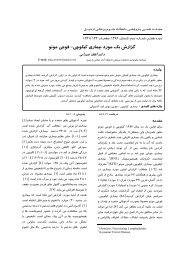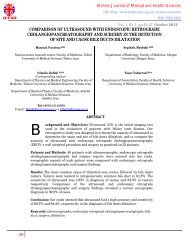The Features of Esophageal Cancer in Ardabil Province Report of a ...
The Features of Esophageal Cancer in Ardabil Province Report of a ...
The Features of Esophageal Cancer in Ardabil Province Report of a ...
You also want an ePaper? Increase the reach of your titles
YUMPU automatically turns print PDFs into web optimized ePapers that Google loves.
Govaresh/ Vol. 16, No.1, Spr<strong>in</strong>g 2011; 55-60<br />
<strong>The</strong> <strong>Features</strong> <strong>of</strong> <strong>Esophageal</strong> <strong>Cancer</strong> <strong>in</strong> <strong>Ardabil</strong> Prov<strong>in</strong>ce:<br />
<strong>Report</strong> <strong>of</strong> a Population-based <strong>Cancer</strong> Registry <strong>in</strong><br />
Northwest Iran<br />
Orig<strong>in</strong>al Article<br />
Pourfarzi F 1 , Barak M 1 , Babaei M 1 , Rahimi G 1 , Malekzadeh R 2 , Yazdanbod A 1<br />
1<br />
Gastro<strong>in</strong>test<strong>in</strong>al <strong>Cancer</strong>s Research Center (GICRC), <strong>Ardabil</strong> University <strong>of</strong> Medical Sciences, <strong>Ardabil</strong>, Iran<br />
2<br />
Digestive Disease Research Center (DDRC), Shariati Hospital, Tehran University <strong>of</strong> Medical Sciences, Tehran, Iran<br />
Background: Evidence shows that the mortality rate <strong>of</strong> esophageal cancer (EC) <strong>in</strong> <strong>Ardabil</strong> Prov<strong>in</strong>ce is among<br />
the highest worldwide. Studies on the epidemiological pr<strong>of</strong>ile <strong>of</strong> EC <strong>in</strong> <strong>Ardabil</strong> are scarce. We aim to study the<br />
characteristics <strong>of</strong> EC <strong>in</strong> <strong>Ardabil</strong> us<strong>in</strong>g data from the recently established <strong>Ardabil</strong> <strong>Cancer</strong> Registry (ACR).<br />
Materials and Methods: This study has been accomplished based on data collected <strong>in</strong> ACR between 2004 and<br />
2006. Cases reported to ACR were coded based on the third edition <strong>of</strong> the International Classification <strong>of</strong> Diseases<br />
for Oncology (ICD-O III). <strong>The</strong> age-standardized <strong>in</strong>cidence rates (ASR) and the standard rate ratio (SRR)<br />
have been calculated for each district <strong>in</strong> <strong>Ardabil</strong> Prov<strong>in</strong>ce.<br />
Results : A total <strong>of</strong> 549 new cases <strong>of</strong> EC were registered with<strong>in</strong> ACR dur<strong>in</strong>g the study period. <strong>The</strong> ASR was<br />
19.5 for men and 19.7 for women per 100,000 person-years. <strong>The</strong> majority <strong>of</strong> cases (79.1%) were diagnosed<br />
based on pathology. <strong>The</strong> most common morphology <strong>of</strong> EC was squamous cell carc<strong>in</strong>oma (SCC, 73%) followed<br />
by adenocarc<strong>in</strong>oma (17.8%). <strong>The</strong> ASR was significantly higher <strong>in</strong> northern districts <strong>of</strong> the prov<strong>in</strong>ce (p < 0.001);<br />
highest <strong>in</strong> Meshk<strong>in</strong>shahr (27.2/100,000) and lowest <strong>in</strong> Nir (7.6/100,000). <strong>The</strong> male:female ratio approximated<br />
one <strong>in</strong> the northern and above 2.5 <strong>in</strong> the southern districts.<br />
Conclusion : Our results demonstrate that the <strong>in</strong>creased <strong>in</strong>cidence <strong>of</strong> EC <strong>in</strong> <strong>Ardabil</strong> is ma<strong>in</strong>ly due to an <strong>in</strong>crease<br />
<strong>in</strong> the <strong>in</strong>cidence <strong>of</strong> esophageal adenocarc<strong>in</strong>oma (ACE) dur<strong>in</strong>g recent years. <strong>The</strong> almost equal <strong>in</strong>cidence <strong>of</strong> EC<br />
among men and women, and its geographical pattern across the prov<strong>in</strong>ce <strong>in</strong>dicate the possible role <strong>of</strong> environmental<br />
risk factors, which need further <strong>in</strong>vestigations.<br />
Keywords: <strong>Esophageal</strong> cancer; Incidence; Mortality; <strong>Ardabil</strong>,Iran<br />
Govaresh/ Vol. 16, No.1, Spr<strong>in</strong>g 2011; 55-60<br />
ABSTRACT<br />
Correspond<strong>in</strong>g author:<br />
Gastro<strong>in</strong>test<strong>in</strong>al <strong>Cancer</strong>s Research Center (GICRC) ,<br />
<strong>Ardabil</strong> University <strong>of</strong> Medical Sciences , <strong>Ardabil</strong>, Iran<br />
Telefax : + 98 451 2246666<br />
E-mail: yazdan40@yahoo.com<br />
Received : 23 Apr. 2011<br />
Edited: 30 May 2011<br />
Accepted : 31 May 2011<br />
INTRODUCTION<br />
<strong>Esophageal</strong> cancer (EC) is the eighth most common<br />
cancer and the sixth most common cause <strong>of</strong> cancer<br />
death worldwide (1). In Iran an estimated total <strong>of</strong><br />
6500 EC cases occur each year, <strong>of</strong> which 5800 patients<br />
die from EC with<strong>in</strong> the same year (2,3). Survival<br />
analysis <strong>of</strong> EC <strong>in</strong> <strong>Ardabil</strong> has revealed that the<br />
mean survival rate for patients with EC is only 12.1<br />
months; therefore, <strong>Ardabil</strong> Prov<strong>in</strong>ce has one <strong>of</strong> the<br />
highest mortality rates for EC <strong>in</strong> the world (4).<br />
<strong>The</strong>re is a dist<strong>in</strong>ct geographical distribution <strong>of</strong> EC <strong>in</strong><br />
Asia which is known as a “Central Asian <strong>Esophageal</strong><br />
<strong>Cancer</strong> Belt” that extends from north central Ch<strong>in</strong>a to<br />
Kazakhstan and northern parts <strong>of</strong> Iran <strong>in</strong> the Caspian<br />
Sea littoral (5). <strong>The</strong> earliest reports <strong>of</strong> high <strong>in</strong>cidence<br />
areas <strong>of</strong> EC <strong>in</strong> northern parts <strong>of</strong> Iran have arisen from<br />
the first population-based cancer registry established<br />
<strong>in</strong> the mid-1960s and early 1970s as a jo<strong>in</strong>t collaboration<br />
between Tehran University <strong>of</strong> Iran and the International<br />
Agency <strong>of</strong> <strong>Cancer</strong> Research (IARC) (6,7).<br />
55<br />
Govaresh/ Vol.16/ No.1/ Spr<strong>in</strong>g 2011
Mehdizadeh et al.<br />
Pourfarzi et al.<br />
Initial results from this cancer registry have emphasized<br />
the very high <strong>in</strong>cidence <strong>of</strong> EC <strong>in</strong> the southeastern<br />
areas <strong>of</strong> the Caspian Sea littoral, which decreased<br />
by mov<strong>in</strong>g toward southwestern regions located a few<br />
hundred kilometers away (6,7).<br />
<strong>Ardabil</strong> Prov<strong>in</strong>ce is one <strong>of</strong> the Azeri <strong>in</strong>habited prov<strong>in</strong>ces<br />
located <strong>in</strong> northwestern Iran, an area 70 km <strong>in</strong>land<br />
from the western Caspian coastl<strong>in</strong>e (Fig. 1), with<br />
an area <strong>of</strong> about 17953 km 2 or 1.09% <strong>of</strong> the total area<br />
<strong>of</strong> Iran. This prov<strong>in</strong>ce consists <strong>of</strong> 9 urban districts:<br />
Meshk<strong>in</strong>shar, Parsabad, Germi and Bilesavar <strong>in</strong> the<br />
northern part; <strong>Ardabil</strong>, Nir and Nam<strong>in</strong> <strong>in</strong> the central<br />
part; and Kousar and Khalkhal <strong>in</strong> the southern region<br />
<strong>of</strong> the prov<strong>in</strong>ce. <strong>The</strong>re is a common border <strong>of</strong> 285.5<br />
km with the Republic <strong>of</strong> Azerbaijan. <strong>The</strong> capital city<br />
<strong>of</strong> <strong>Ardabil</strong> is located <strong>in</strong> the center <strong>of</strong> the prov<strong>in</strong>ce,<br />
where the majority <strong>of</strong> diagnostic and treatment facilities<br />
are located. Sabalan Mounta<strong>in</strong>, a silent volcano<br />
located <strong>in</strong> Meshk<strong>in</strong>shahr district, is the third highest<br />
mounta<strong>in</strong> <strong>in</strong> Iran with an altitude <strong>of</strong> 4821 m. Accord<strong>in</strong>g<br />
to the 2006 census, the population <strong>of</strong> <strong>Ardabil</strong><br />
Prov<strong>in</strong>ce is 1,228,155 (1.9% <strong>of</strong> the total population <strong>of</strong><br />
Iran). <strong>The</strong> population <strong>of</strong> <strong>Ardabil</strong> is relatively young,<br />
with 76% below the age <strong>of</strong> 40 years.<br />
A population-based cancer survey conducted between<br />
1996 and 2000 <strong>in</strong> <strong>Ardabil</strong> Prov<strong>in</strong>ce showed that EC<br />
was the second most frequent cancer <strong>in</strong> both genders<br />
(8). Accord<strong>in</strong>g to Babaei et al., a recently published<br />
report from the <strong>Ardabil</strong> <strong>Cancer</strong> Registry (ACR) noted<br />
a slightly <strong>in</strong>creased <strong>in</strong>cidence <strong>of</strong> EC over a 4 year<br />
time period <strong>in</strong> <strong>Ardabil</strong> Prov<strong>in</strong>ce (9).<br />
Fig. 1: Districts <strong>of</strong> <strong>Ardabil</strong> Prov<strong>in</strong>ce.<br />
This study aims to provide an updated report <strong>of</strong> ACR.<br />
It is the first ongo<strong>in</strong>g population-based cancer registry<br />
<strong>in</strong> Iran that was established <strong>in</strong> 2003 with collaboration<br />
<strong>of</strong> the International Agency for Research on<br />
<strong>Cancer</strong> (IARC), Digestive Diseases Research Center<br />
(DDRC) <strong>of</strong> Tehran University, and <strong>Ardabil</strong> University<br />
<strong>of</strong> Medical Sciences (ARUMS). ACR provides data<br />
on cancer <strong>in</strong>cidence and stage at time <strong>of</strong> diagnosis<br />
from hospitals, pathology laboratories, radiology centers,<br />
ambulatory surgical centers, chemotherapy facilities,<br />
the Drug and Alcohol Investigation Unit and<br />
physicians’ <strong>of</strong>fices.<br />
MATERIALS AND METHODS<br />
Data from all newly diagnosed EC cases between<br />
2004 and 2006 were actively collected by ACR. Cases<br />
reported to ACR were <strong>in</strong>itially checked for duplication,<br />
were then def<strong>in</strong>ed by codes accord<strong>in</strong>g to the third<br />
edition <strong>of</strong> the International Classification <strong>of</strong> Diseases<br />
for Oncology (ICD-O III), and were f<strong>in</strong>ally entered<br />
<strong>in</strong>to a database (10). <strong>The</strong> collected data <strong>in</strong>cluded: age,<br />
gender and place <strong>of</strong> residence, method <strong>of</strong> diagnosis,<br />
morphology, and orig<strong>in</strong> <strong>of</strong> the cancer.<br />
Crude <strong>in</strong>cidence rates and age-standardized <strong>in</strong>cidence<br />
rates (ASR) were calculated for both men and women,<br />
and for each <strong>of</strong> the 9 districts <strong>of</strong> <strong>Ardabil</strong> Prov<strong>in</strong>ce.<br />
<strong>The</strong> standard rate ratio (SRR) was separately<br />
calculated for each district and comparedbetween districts.<br />
To avoid the effect <strong>of</strong> compar<strong>in</strong>g heavily populated<br />
districts (e.g., <strong>Ardabil</strong> district with 40% <strong>of</strong> the<br />
prov<strong>in</strong>ce’s total population), with the prov<strong>in</strong>ce rate,<br />
the rate for each district was compared with the rate<br />
<strong>in</strong> the rema<strong>in</strong>der <strong>of</strong> <strong>Ardabil</strong> Prov<strong>in</strong>ce (e.g., Meshk<strong>in</strong>shahr<br />
with total prov<strong>in</strong>ce m<strong>in</strong>us Meshk<strong>in</strong>shahr ). We<br />
have corrected the results for cases with unknown age<br />
by multiply<strong>in</strong>g the standardized rate (based on cases<br />
with known age) by T/K, where T is the total number<br />
<strong>of</strong> cases <strong>of</strong> cancer with the same type <strong>in</strong> cases <strong>of</strong> the<br />
same sex and K is the number occurr<strong>in</strong>g <strong>in</strong> cases with<br />
known age (11).<br />
RESULTS<br />
Dur<strong>in</strong>g the study period, 549 new cases <strong>of</strong> EC were<br />
registered. Diagnosis was based on death certificate<br />
only (DCO=12.9%) <strong>in</strong> 71 cases, cl<strong>in</strong>ical exam<strong>in</strong>ation<br />
only (4.3%), cl<strong>in</strong>ical/paracl<strong>in</strong>ical <strong>in</strong>vestigation<br />
(3.3%), and confirmed pathology (79.1%). ASR <strong>of</strong> EC<br />
was 19.5 <strong>in</strong> men and 19.7 <strong>in</strong> women per 100,000 person-years<br />
(Table 1). <strong>The</strong> most common morphology<br />
Govaresh/ Vol.16/ No.1/ Spr<strong>in</strong>g 2011 56
<strong>Esophageal</strong> <strong>Cancer</strong> <strong>in</strong><br />
<strong>Ardabil</strong> Prov<strong>in</strong>ce<br />
<strong>in</strong> our cases was squamous cell carc<strong>in</strong>oma (SCC,<br />
73%). <strong>Esophageal</strong> adenocarc<strong>in</strong>oma (ACE) accounted<br />
for 17.8% <strong>of</strong> all cases. In 35.5% <strong>of</strong> cases the tumor<br />
orig<strong>in</strong>ated <strong>in</strong> the middle third <strong>of</strong> the esophagus (Table<br />
2), whereas the lower third constituted 32.4% <strong>of</strong> casesand<br />
was significantly more common <strong>in</strong> men. <strong>The</strong><br />
risk <strong>of</strong> cancer orig<strong>in</strong>at<strong>in</strong>g <strong>in</strong> the middle third <strong>of</strong> the<br />
esophagus was higher among women compared to<br />
men. <strong>The</strong> <strong>in</strong>cidence <strong>of</strong> EC was significantly higher <strong>in</strong><br />
northern parts <strong>of</strong> the prov<strong>in</strong>ce. <strong>The</strong> highest <strong>in</strong>cidence<br />
rate (27.2/100,000) was detected <strong>in</strong> Meshk<strong>in</strong>shahr, a<br />
district close to the silent volcano <strong>of</strong> Sabalan. <strong>The</strong> <strong>in</strong>cidence<br />
<strong>of</strong> EC <strong>in</strong> southern <strong>Ardabil</strong> Prov<strong>in</strong>ce, such as<br />
Khalkhal and Kosar, was significantly lower than the<br />
rest <strong>of</strong> the prov<strong>in</strong>ce. <strong>The</strong> lowest <strong>in</strong>cidence rate was<br />
observed <strong>in</strong> Nir district (7.6/100,000). <strong>The</strong> male to female<br />
ratio was around one <strong>in</strong> northern and above 2.5<br />
<strong>in</strong> southern districts (Table 3, Fig. 1). Figure 2 shows<br />
the age-specific crude rate <strong>of</strong> EC by sex ris<strong>in</strong>g with<br />
age with a little notch<strong>in</strong>g <strong>in</strong> the 80-84 age groups <strong>in</strong><br />
Table 1: Age-standardized <strong>in</strong>cidence rate (ASR) <strong>of</strong> esophagus cancer <strong>in</strong> males and females (<strong>Ardabil</strong>, 2004-6).<br />
<strong>Cancer</strong> Total Crude Rate<br />
ASR<br />
95% CI Cumulative Risk<br />
(W) Lower Upper 0-64 0-74<br />
Male 290 14.2 19.5 17.0 22.0 0.9 2.3<br />
Female 259 13.6 19.7 17.2 22.2 1.0 2.1<br />
Both sexes 549 13.9 19.7 17.92 21.48 0.99 2.24<br />
Table 2: Subtypes <strong>of</strong> esophageal cancer (<strong>Ardabil</strong>, 2004-6).<br />
Female Male Total (%)<br />
Upper third <strong>of</strong> esophagus 16 8 24 (5.0)<br />
Middle third <strong>of</strong> esophagus 91 79 170 (35.5)<br />
Lower third <strong>of</strong> esophagus 53 102 155 (32.4)<br />
Overl. lesion <strong>of</strong> esophagus 4 0 4 (0.8)<br />
Esophagus, NOS 60 65 125 (26.1)<br />
Total 224 254 478 (100)<br />
Overl.=Overlapp<strong>in</strong>g<br />
NOS=Not otherwise specified<br />
Table 3: Rank<strong>in</strong>g <strong>of</strong> <strong>Ardabil</strong> districts for esophageal cancer, both sexes (<strong>Ardabil</strong>, 2004-6).<br />
Rank<strong>in</strong>g<br />
District ASR SE SRR Male/female ratio<br />
1 Meshk<strong>in</strong>Shahr 27.2 /++ 3.9 1.47 1.1<br />
2 Parsabad 22.3 /++ 4.7 1.14 1.19<br />
3 Germi 21.2 /+ 4.5 1.09 0.80<br />
4 Nam<strong>in</strong> 18.1 /NS 4.9 0.92 1.36<br />
5 <strong>Ardabil</strong> 16.3 /NS 1.8 0.82 0.94<br />
6 Kousar 14.6 /- 7.4 0.74 6.0<br />
7 BileSavar 14.1 /- 4.9 0.71 0.64<br />
8 Khalkhal 15.2 /- 3.6 0.69 2.44<br />
9 Nir 7.6 /- - 4.6 0.38 4.0<br />
ASR= Age-standardized rate (direct method)<br />
SE= Standard error<br />
SRR= Standard rate ratio (<strong>in</strong>direct method)<br />
/++= Significantly higher than rema<strong>in</strong>der <strong>of</strong> <strong>Ardabil</strong> Prov<strong>in</strong>ce, p
Pourfarzi et al.<br />
**In this figure, change the follow<strong>in</strong>g: “Age Groups” to “Age groups”.<br />
Fig. 2: Age specific crude rate <strong>of</strong> esophageal cancer <strong>in</strong> males and females, (<strong>Ardabil</strong>-2004-6).<br />
both sexes. <strong>The</strong> explanation for such a notch can be<br />
<strong>in</strong>accurate record<strong>in</strong>g <strong>of</strong> age <strong>in</strong> elderly cases, underascerta<strong>in</strong>ment<br />
<strong>in</strong> this age group, or just a random<br />
variation.<br />
DISCUSSION<br />
Despite a decl<strong>in</strong><strong>in</strong>g trend <strong>in</strong> the <strong>in</strong>cidence <strong>of</strong> esophageal<br />
SCC <strong>in</strong> most parts <strong>of</strong> the world, the rate <strong>of</strong> ACE<br />
is rapidly <strong>in</strong>creas<strong>in</strong>g, particularly <strong>in</strong> Western countries<br />
(12-14). As recently as 1975, about 75% <strong>of</strong> EC<br />
cases diagnosed <strong>in</strong> the United States were SCC and<br />
the rema<strong>in</strong><strong>in</strong>g 25% were adenocarc<strong>in</strong>omas. Dur<strong>in</strong>g<br />
the past 20 years, the <strong>in</strong>cidence <strong>of</strong> SCC has decreased<br />
<strong>in</strong> the US population, while the rate <strong>of</strong> adenocarc<strong>in</strong>oma<br />
has <strong>in</strong>creased among white men by 450% and<br />
among black men by 50% (15,16). Up to 2005, SCC<br />
had been reported as the most prevalent type <strong>of</strong> EC <strong>in</strong><br />
develop<strong>in</strong>g countries <strong>in</strong>clud<strong>in</strong>g Iran and Ch<strong>in</strong>a, and<br />
accounted for over 90% <strong>of</strong> cases (16). Recent reports<br />
from the Gonbad area <strong>in</strong> northeast Iran also <strong>in</strong>dicate a<br />
high prevalence for esophageal SCC (17). Our study<br />
clearly has shown an <strong>in</strong>creas<strong>in</strong>g <strong>in</strong>cidence <strong>of</strong> ACE <strong>in</strong><br />
<strong>Ardabil</strong>. <strong>The</strong> proportion <strong>of</strong> ACE has <strong>in</strong>creased from<br />
less than 15% ten years ago to more than 27% <strong>in</strong> this<br />
study (16). This is <strong>in</strong> agreement with recent epidemiologic<br />
evidence from Iran show<strong>in</strong>g an <strong>in</strong>crease <strong>in</strong> adenocarc<strong>in</strong>oma<br />
prevalence (17,18) and is at least partly<br />
due to the epidemic <strong>of</strong> obesity and gastro-esophageal<br />
reflux disease <strong>in</strong> Iran, specifically <strong>in</strong> <strong>Ardabil</strong> dur<strong>in</strong>g<br />
the past 30 years (19-22). This <strong>in</strong>crease <strong>in</strong> ACE rate<br />
parallels a high rate <strong>of</strong> esophageal SCC and contributes<br />
to the <strong>in</strong>creas<strong>in</strong>g rate <strong>of</strong> EC <strong>in</strong> <strong>Ardabil</strong>.<br />
<strong>The</strong> ASR <strong>of</strong> EC is 19.5 <strong>in</strong> men and 19.7 <strong>in</strong> women<br />
per 100,000. This rate is higher than that reported <strong>in</strong><br />
the first cancer surveillance <strong>in</strong> <strong>Ardabil</strong> Prov<strong>in</strong>ce dur<strong>in</strong>g<br />
a period <strong>of</strong> four years (1996-1999). Accord<strong>in</strong>g to<br />
this report, EC ranked second among the five most<br />
common cancers <strong>in</strong> <strong>Ardabil</strong> with an ASR <strong>of</strong> 15.4 per<br />
100,000 for men and 14.4 per 100,000 for women (8).<br />
<strong>The</strong> explanation for this <strong>in</strong>crease <strong>in</strong> the <strong>in</strong>cidence <strong>of</strong><br />
EC is probably two fold; an <strong>in</strong>crease <strong>in</strong> the <strong>in</strong>cidence<br />
<strong>of</strong> ACE and misclassification <strong>of</strong> gastric cardia cancer<br />
as EC. A concurrent <strong>in</strong>crease <strong>in</strong> the rate <strong>of</strong> ACE<br />
and gastric cardia cancer, which has already been reported<br />
from <strong>Ardabil</strong> is <strong>in</strong> l<strong>in</strong>e with this observation<br />
(19,23,24). <strong>The</strong> etiology and risk factors for SCC <strong>in</strong><br />
northeastern Iran have been extensively studied dur<strong>in</strong>g<br />
the past 10 years (2,6,16). Accord<strong>in</strong>g to the results<br />
<strong>of</strong> these studies the ma<strong>in</strong> risk factors are: consumption<br />
<strong>of</strong> hot tea (OR=10), non-hygienic water (OR=8),<br />
fried and grilled meat (OR=7.5),family history <strong>of</strong> EC<br />
(OR=2.3), opium consumption (OR=2.2 ), smok<strong>in</strong>g<br />
tobacco (OR= 1.8) (25-27). <strong>The</strong> ma<strong>in</strong> suspected mutagens<br />
are N-nitroso compounds and polycyclic aromatic<br />
hydrocarbons (28,29).<br />
EC occurs more frequently <strong>in</strong> men than women with a<br />
male to female ratio <strong>of</strong> 3 throughout different countries.<br />
However, the <strong>in</strong>cidence is approximately equal for both<br />
genders <strong>in</strong> high <strong>in</strong>cidence areas with the male to female<br />
ratio close to 1 (8). In the current report, <strong>in</strong> the male<br />
to female ratio <strong>of</strong> EC is almost one <strong>Ardabil</strong> Prov<strong>in</strong>ce<br />
(1.01), which is <strong>in</strong> agreement with similar reports from<br />
Govaresh/ Vol.16/ No.1/ Spr<strong>in</strong>g 2011 58
<strong>Esophageal</strong> <strong>Cancer</strong> <strong>in</strong><br />
<strong>Ardabil</strong> Prov<strong>in</strong>ce<br />
other high <strong>in</strong>cidence areas such as northeast Iran and<br />
L<strong>in</strong>xian Ch<strong>in</strong>a., This f<strong>in</strong>d<strong>in</strong>g can provide plausible evidence<br />
for the role <strong>of</strong> different types <strong>of</strong> environmental<br />
risk factors <strong>in</strong> EC <strong>in</strong>cidence. In addition, the <strong>in</strong>cidence<br />
<strong>of</strong> EC was significantly higher <strong>in</strong> northern parts <strong>of</strong> the<br />
prov<strong>in</strong>ce. <strong>The</strong> highest <strong>in</strong>cidence rates were observed <strong>in</strong><br />
Meshk<strong>in</strong>shahr, Parsabad and Germi. In these districts<br />
the male/female ratio was almost one and similar to<br />
those <strong>of</strong> a high <strong>in</strong>cidence area, while the <strong>in</strong>cidence <strong>in</strong><br />
the southern parts <strong>of</strong> the prov<strong>in</strong>ce (Khalkhal and Kosar)<br />
was significantly lower, with the male to female<br />
ratios greater than 2.5. <strong>The</strong> ASRs as well as sex distribution<br />
were similar to Western countries.<br />
CONCLUSION<br />
Our data show that EC is the second most common<br />
cancer <strong>in</strong> <strong>Ardabil</strong>, with a trend toward an <strong>in</strong>crease<br />
<strong>in</strong> the rate <strong>of</strong> ACE. Further studies are necessary to<br />
determ<strong>in</strong>e risk factors <strong>of</strong> EC <strong>in</strong> the northwest areas<br />
<strong>of</strong> <strong>Ardabil</strong> Prov<strong>in</strong>ce, <strong>in</strong> comparison with northeastern<br />
Iran.<br />
ACKNOWLEDGEMENTS<br />
<strong>The</strong> authors gratefully acknowledge the k<strong>in</strong>d contributions<br />
<strong>of</strong> Dr. Ram<strong>in</strong> Nasimidoust <strong>in</strong> accomplish<strong>in</strong>g<br />
this study <strong>in</strong> <strong>Ardabil</strong> Prov<strong>in</strong>ce.<br />
RERERENCES<br />
1. Ferlay J, Bray F, Pisani P, Park<strong>in</strong> DM. GLOBOCAN 2002:<br />
<strong>Cancer</strong> Incidence, Mortality and Prevalence Worldwide Version<br />
2.0. Lyon: IARCPress; 2004.<br />
2. Malekzadeh R, Semnani SH.,Sajadi AR. <strong>Esophageal</strong> cancer<br />
<strong>in</strong> Iran .Govaresh 2008; 13:25-34.<br />
3. Sadjadi A, Nouraie M, Mohagheghi MA, Mousavi-Jarrahi<br />
A, Malekezadeh R, Park<strong>in</strong> DM. <strong>Cancer</strong> occurrence <strong>in</strong> Iran <strong>in</strong><br />
2002, an <strong>in</strong>ternational perspective. Asian Pac J <strong>Cancer</strong> Prev<br />
2005;6:359-63.<br />
4. Samadi F, Babaei M, Yazdanbod A, Fallah M, Nouraie M,<br />
Nasrollahzadeh D,et al. Survival rate <strong>of</strong> gastric and esophageal<br />
cancers <strong>in</strong> <strong>Ardabil</strong> prov<strong>in</strong>ce, North-West <strong>of</strong> Iran. Arch<br />
Iran Med 2007;10:32-7.<br />
5. Boyle P, Lev<strong>in</strong> B. World cancer report 2008. Lyon: International<br />
Agency for Research on <strong>Cancer</strong> (IARC) press 2008.<br />
6. Kamangar F, Malekzadeh R, Dawsey SM, Saidi F. <strong>Esophageal</strong><br />
cancer <strong>in</strong> Northeastern Iran: a review. Arch Iran Med<br />
2007;10:70-82.<br />
7. Marjani HA, Biramijamal F, Hosse<strong>in</strong>-Nezhad A, Islami F,<br />
Pourshmas A, Semnani S. Prevalence <strong>of</strong> esophageal cancer<br />
risk factors among Turkmen and non-Turkmen ethnic groups<br />
<strong>in</strong> a high <strong>in</strong>cidence area <strong>in</strong> Iran. Arch Iran Med 2010;13:<br />
111 –5.<br />
8. Sadjadi A, Malekzadeh R, Derakhshan MH, Sepehr A, Nouraie<br />
M, Sotoudeh M, et al. <strong>Cancer</strong> occurrence <strong>in</strong> <strong>Ardabil</strong>:<br />
results <strong>of</strong> a population-based cancer registry from Iran. Int J<br />
<strong>Cancer</strong> 2003;107:113-8.<br />
9. Babaei M , Jaafarzadeh H , Sadjadi AR, Samadi F,Yazdanbod<br />
A,Fallah,et al. <strong>Cancer</strong> Incidence and Mortality <strong>in</strong> <strong>Ardabil</strong>:<br />
<strong>Report</strong> <strong>of</strong> an Ongo<strong>in</strong>g Population-Based <strong>Cancer</strong> Registry <strong>in</strong><br />
Iran, 2004-2006. Iran J Public Health 2009;38:35-45.<br />
10. Fritz AG. International classification <strong>of</strong> diseases for oncology<br />
= ICD-O. 3rd ed. Geneva: World Health Organization;<br />
2000.<br />
11. Doll R, Smith PG. Comparison between registries: Age-standardized<br />
rates. In: Waterhouse J, Muir C, Shanmugaratnam<br />
K, Powell J, editors. <strong>Cancer</strong> <strong>in</strong>cidence <strong>in</strong> five cont<strong>in</strong>ents.<br />
Lyon: International Agency for Research on <strong>Cancer</strong>; 1982.<br />
p. 671-4.<br />
12. Semnani S, Sadjadi A, Fahimi S, Nouraie M, Naeimi M,<br />
Kabir J,et al. Decl<strong>in</strong><strong>in</strong>g <strong>in</strong>cidence <strong>of</strong> esophageal cancer <strong>in</strong><br />
the Turkmen Pla<strong>in</strong>, eastern part <strong>of</strong> the Caspian Littoral <strong>of</strong><br />
Iran: a retrospective cancer surveillance. <strong>Cancer</strong> Detect Prev<br />
2006;30:14-9.<br />
13. Thomas RJ, Lade S, Giles GG, Thursfield V. Incidence trends<br />
<strong>in</strong> oesophageal and proximal gastric carc<strong>in</strong>oma <strong>in</strong> Victoria.<br />
Aust N Z J Surg 1996;66:271-5.<br />
14. Devesa SS, Blot WJ, Fraumeni JF Jr. Chang<strong>in</strong>g patterns <strong>in</strong><br />
the <strong>in</strong>cidence <strong>of</strong> esophageal and gastric carc<strong>in</strong>oma <strong>in</strong> the<br />
United States. <strong>Cancer</strong> 1998;83:2049-53.<br />
15. Blot WJ, McLaughl<strong>in</strong> JK. <strong>The</strong> chang<strong>in</strong>g epidemiology <strong>of</strong><br />
esophageal cancer. Sem<strong>in</strong> Oncol 1999;26:2-8.<br />
16. Islami F, Kamangar F, Nasrollahzadeh D, Møller H, B<strong>of</strong>fetta<br />
P, Malekzadeh R. Oesophageal cancer <strong>in</strong> Golestan Prov<strong>in</strong>ce,<br />
a high-<strong>in</strong>cidence area <strong>in</strong> northern Iran - a review.Eur J <strong>Cancer</strong><br />
2009;45:3156-65.<br />
17. Islami F, Kamangar F, Aghcheli K, Fahimi S, Semnani S,<br />
Taghavi N, et al. Epidemiologic features <strong>of</strong> upper gastro<strong>in</strong>test<strong>in</strong>al<br />
tract cancers <strong>in</strong> Northeastern Iran. Br J <strong>Cancer</strong><br />
2004;90:1402-6.<br />
18. Derakhshan MH, Yazdanbod A, Sadjadi AR, Shokoohi B,<br />
McColl KE, Malekzadeh R.High <strong>in</strong>cidence <strong>of</strong> adenocarc<strong>in</strong>oma<br />
aris<strong>in</strong>g from the right side <strong>of</strong> the gastric cardia <strong>in</strong> NW<br />
Iran. Gut 2004;53:1262-6.<br />
19. Derakhshan MH, Malekzadeh R, Watabe H, Yazdanbod A,<br />
Fyfe V, Kazemi A, et al. Comb<strong>in</strong>ation <strong>of</strong> gastric atrophy, reflux<br />
symptoms and histological subtype <strong>in</strong>dicates two dist<strong>in</strong>ct<br />
aetiologies <strong>of</strong> gastric cardia cancer. Gut 2008;57:298-<br />
305.<br />
20. Malekzadeh R, Mohamadnejad M, Merat S, Pourshams A,<br />
Etemadi A. Obesity pandemic: An Iranian perspective. Arch<br />
Iran Med 2005;8:1-7.<br />
21. Malekzadeh R, Nasseri-Moghaddam S, Sotoudeh M. Gastroesophageal<br />
reflux disease: <strong>The</strong> new epidemic. Arch Iran<br />
59<br />
Govaresh/ Vol.16/ No.1/ Spr<strong>in</strong>g 2011
Pourfarzi et al.<br />
Med 2003;6:127-40.<br />
22. Malekzadeh R, Sotoudeh M, Derakhshan MH, Mikaeli J,<br />
Yazdanbod A, Merat S, et al. Prevalence <strong>of</strong> gastric precancerous<br />
lesions <strong>in</strong> <strong>Ardabil</strong>, a high <strong>in</strong>cidence prov<strong>in</strong>ce for gastric<br />
adenocarc<strong>in</strong>oma <strong>in</strong> the northwest <strong>of</strong> Iran. J Cl<strong>in</strong> Pathol<br />
2004; 57:37-42.<br />
23. Yazdanbod A, Arshi S, Derakhshan MH, Sadjadi A,<br />
Malekzadeh R. Gastric Cardia <strong>Cancer</strong>; <strong>The</strong> Most Common<br />
Type <strong>of</strong> Upper Gastro<strong>in</strong>test<strong>in</strong>al <strong>Cancer</strong> <strong>in</strong> <strong>Ardabil</strong>, Iran: An<br />
Endoscopy Cl<strong>in</strong>ic Experience. Arch Iran Med 2001;4:76-9.<br />
24. Haghdoost AA, Hosse<strong>in</strong>i H, Chamani G, Zarei MR, Rad<br />
M, Hashemipoor M, et al. Ris<strong>in</strong>g <strong>in</strong>cidence <strong>of</strong> adenocarc<strong>in</strong>oma<br />
<strong>of</strong> the esophagus <strong>in</strong> Kerman, Iran. Arch Iran Med<br />
2008;11:364-70.<br />
25. Islami F, Nasrollahzadeh D, Kamangar F. Tea dr<strong>in</strong>k<strong>in</strong>g habits<br />
and risk <strong>of</strong> esophageal cancer <strong>in</strong> northern Iran 2008. BMJ<br />
2009;338:b929.<br />
26. Akbari MR, Malekzadeh R, Nasrollahzadeh D, Amanian D,<br />
Sun P, Islami F, et al. Familial risks <strong>of</strong> esophageal cancer<br />
among the Turkmen population <strong>of</strong>the Caspian Littoral <strong>of</strong><br />
Iran. Int J <strong>Cancer</strong> 2006;119:1047-51.<br />
27. Nasrollahzadeh D, Kamangar F, Aghcheli K, Sotoudeh M,<br />
Islami F, Abnet C, et al. Opium, tobacco, and alcohol use <strong>in</strong><br />
relation to oesophageal squamous cell carc<strong>in</strong>oma <strong>in</strong> a highrisk<br />
area <strong>of</strong> Iran. Br J <strong>Cancer</strong> 2008;98:1857-63.<br />
28. Abedi-Ardekani B, Kamangar F, Hewitt SM, Ha<strong>in</strong>aut P,<br />
Sotoudeh M, Abnet CC,et al. Polycyclic aromatic hydrocarbon<br />
exposure <strong>in</strong> oesophageal tissue and risk <strong>of</strong> oesophageal<br />
squamous cell carc<strong>in</strong>oma <strong>in</strong> north-eastern Iran. Gut<br />
2010;59:1178-83.<br />
29. Ponder B. Polycyclic aromatic hydrocarbon exposure <strong>in</strong> oesophageal<br />
tissue and risk <strong>of</strong> oesophageal squamous cell carc<strong>in</strong>oma<br />
<strong>in</strong> north-eastern Iran . Arch Iran Med 2010,13,457-8.<br />
Govaresh/ Vol.16/ No.1/ Spr<strong>in</strong>g 2011 60


